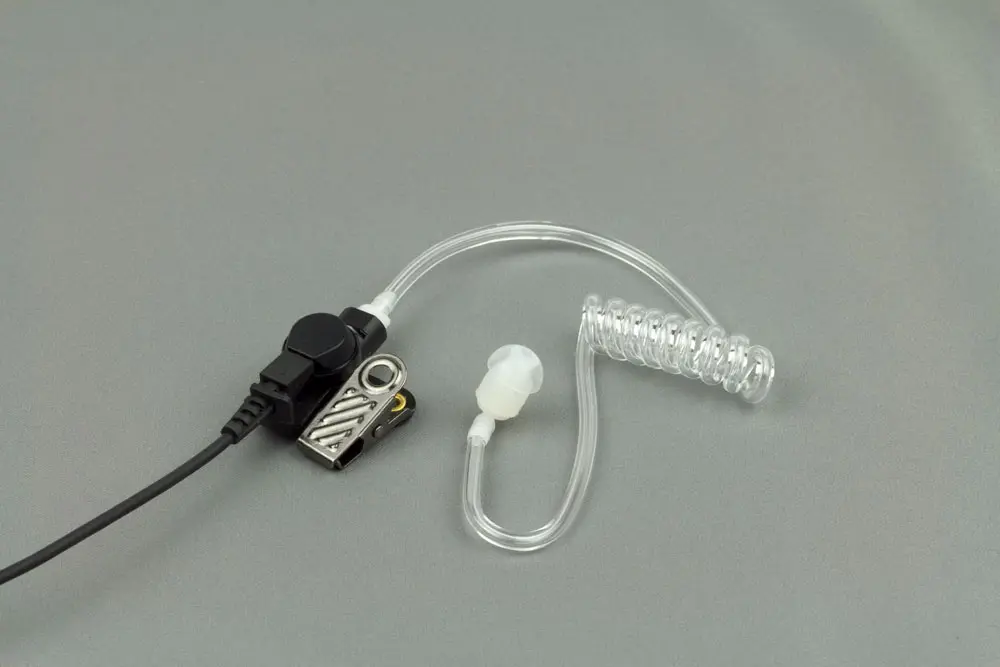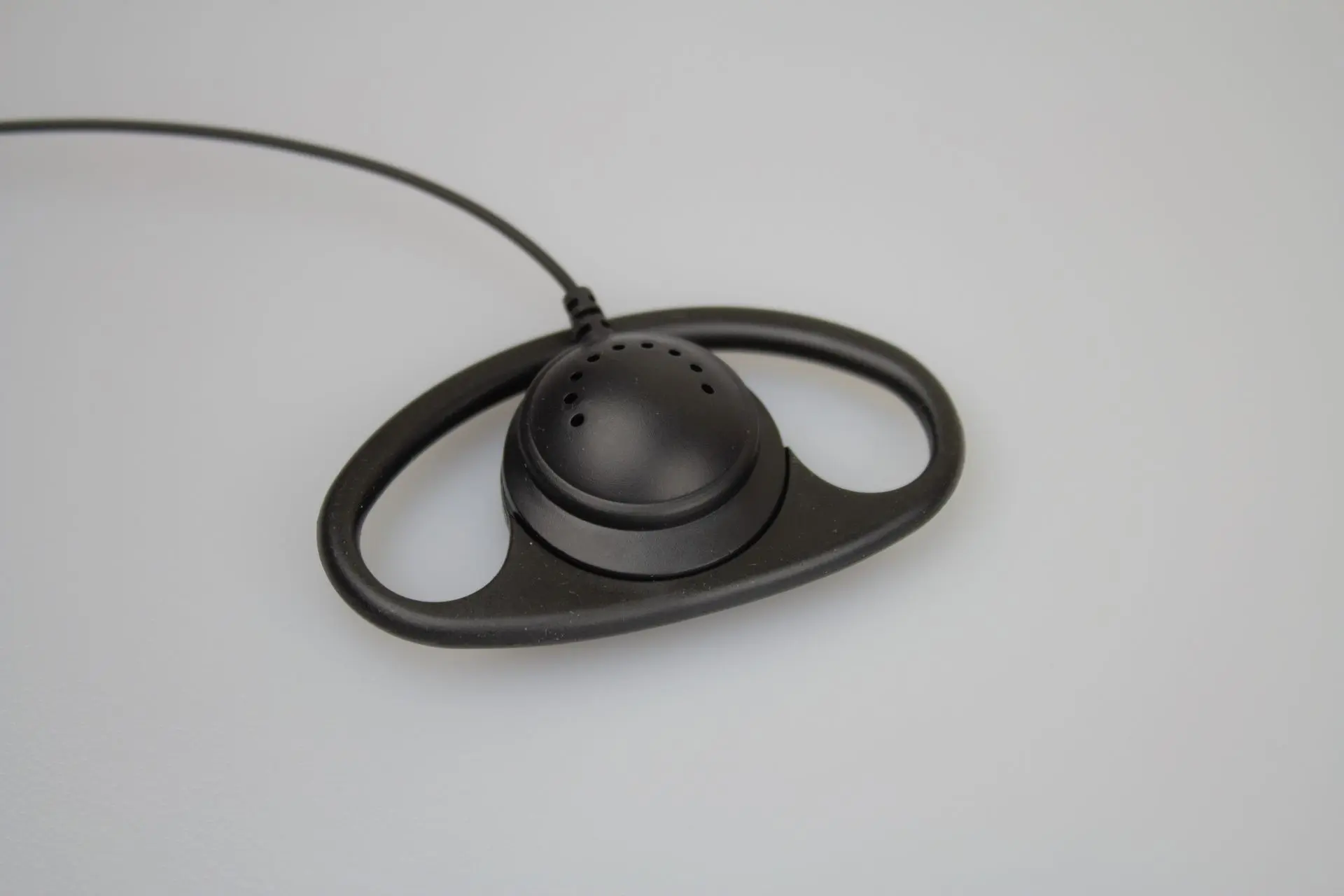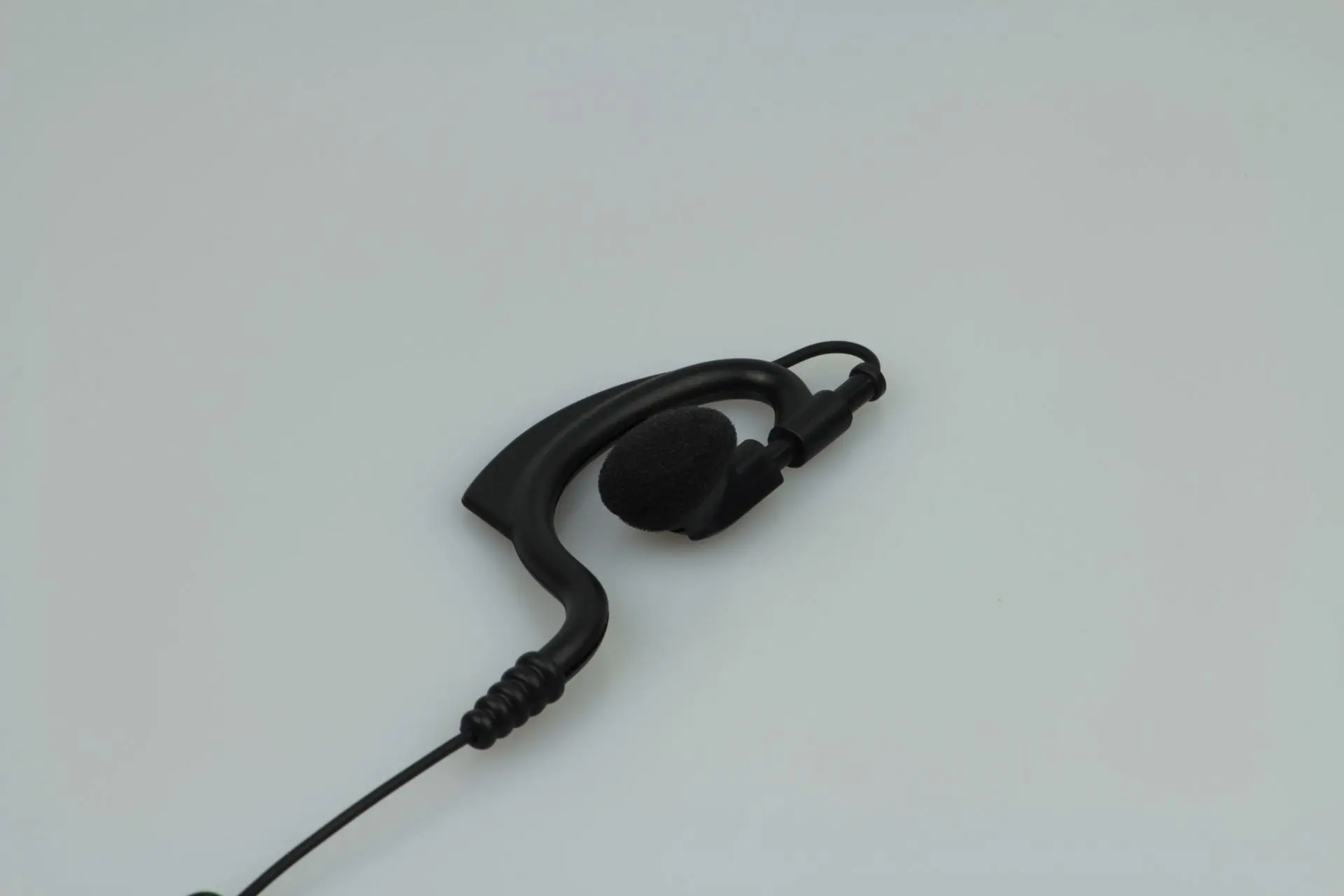Choosing the right earpiece for your two-way radio can dramatically improve communication clarity and comfort during long shifts. Whether you're working in security, hospitality, construction, or retail, the earpiece style you select affects discretion, hygiene, durability, and overall user experience. This guide compares the three most popular earpiece styles - acoustic tube, D-shape, and C-shape - to help you make the best choice for your working environment.
Note that different manufacturer designs will differ slightly and this information is subjective and generalised. Images are for illustrative purposes only. Please speak to us if you have specific questions that we haven't addressed here.
1. Acoustic Tube Earpiece
(Also known as "surveillance style", "matrix style" or "FBI style")

Acoustic Tube Style Earpiece for two-way radio
Description:
Clear coiled acoustic tube routes sound discreetly from the transducer (speaker) to the ear. Typically comes with a small earbud that sits inside the ear canal. A clip secures the transducer to the users clothing.
Pros:
- Very discreet; ideal for security, hospitality, and covert use.
- Isolates sound well in noisy environments.
- Acoustic tube separates electronics from the ear, so it's often better for hygiene in shared-use scenarios (tube and earbud can be replaced).
- Can be worn comfortably under clothing.
Cons:
- May be uncomfortable for long-term wear inside the ear.
- Acoustic tube can degrade or become blocked over time.
- Less robust than other types in very physical or dirty environments.
- Audio can sound slightly muffled due to the tube.
Best For:
Security guards, hotel staff, retail managers, event coordinators, and discrete communications.
2. D-Shape Earpiece
(Also called “D-loop” or “D-ring”)

D Shape Earpiece for two-way radio
Description:
A rigid or semi-rigid D-shaped loop that fits around the outside of the ear with the speaker resting against the ear surface (not inside).
Pros:
- Very comfortable for all-day use; doesn’t go into the ear.
- Easy to put on and take off quickly.
- Suitable for shared users (no in-ear hygiene concerns).
- Robust design, suitable for general business and industrial use.
Cons:
- Less secure fit than in-ear types; may shift during physical activity.
- Sound leakage possible in very noisy environments.
- Can interfere with glasses or hearing protection.
Best For:
General users, warehouse operatives, shop floor staff, light industrial environments.
3. C-Shape Earpiece
(Also known as "G-shape", “earhanger” or “soft loop” or similar)

C or G Shape Earpiece for two-way radio
Description:
Flexible earhanger wraps around the ear with a speaker that rests on or near the ear. Usually made of soft silicone or plastic for comfort.
Pros:
- More secure fit than D-shape for active users.
-
Comfortable for extended wear, even with glasses.
- Durable and widely compatible.
Cons:
- Not as discreet as acoustic tube models.
- Can still become uncomfortable after very long wear periods.
- Not fully sealed against noise – may be hard to hear in very loud settings.
Best For:
Construction workers, logistics teams, outdoor events, and where secure fit is important.
Summary Table
| Feature | Acoustic Tube | D-Shape | C-Shape |
| Discretion | ★★★★★ | ★★☆☆☆ | ★★★☆☆ |
| Comfort (long use) | ★★★☆☆ | ★★★★☆ | ★★★★☆ |
| Security of fit | ★★★★☆ | ★★☆☆☆ | ★★★★☆ |
| Audio Clarity | ★★★☆☆ | ★★★★☆ | ★★★★☆ |
| Durability | ★★★☆☆ | ★★★★☆ | ★★★★☆ |
| Best Use Case | Covert / Hospitality | General business | Active / Industrial |
Frequently Asked Questions
Can I use any earpiece with my two-way radio?
No, earpieces must match your specific radio's connector type. Motorola, Kenwood, Hytera, Opus, Icom and other manufacturers use different connector designs with varying pin spacing and configurations. Even within brands, different radio models may require different connectors. Always verify your radio model and connector type before purchasing. If you're unsure, contact us on 03300 88 17 80 with your radio model number.
Which earpiece style is most comfortable for long shifts?
Comfort varies by individual preference and working environment. Acoustic tube earpieces are popular for extended wear because the soft silicone earbud sits gently in the ear canal without applying pressure. However, some users find C-shaped (G-shaped) earpieces more comfortable as they distribute weight around the outer ear. D-shape earpieces can cause discomfort during shifts exceeding 6-8 hours as the rigid hook presses against the ear. We recommend trying different styles to find what works best for you.
How often should I replace acoustic tube components?
The silicone earbuds should be replaced regularly for hygiene reasons. The acoustic tube itself should be inspected regularly for blockages, tears or discolouration and replaced when sound quality degrades. D-shape and C-shape earpieces should be wiped clean with antibacterial wipes after each shift, especially when shared (not recommended).
Which earpiece is best for noisy environments?
For extremely loud environments such as construction sites, manufacturing floors or busy venues, in-ear styles that create a seal (acoustic tube with foam tips or moulded earpieces) provide better noise isolation than over-ear D-shape or C-shape designs. However, acoustic tube earpieces may still struggle in very high noise levels. For maximum performance in loud settings, consider heavy-duty headsets with noise-cancelling microphones.
Are acoustic tube earpieces waterproof?
Most acoustic tube earpieces are water-resistant, not waterproof. They can handle light rain, splashes and humid conditions, but should not be submerged in water.
Can I wear an earpiece with glasses or hearing aids?
Yes. Acoustic tube earpieces work well with glasses as the tube runs behind the ear without interfering with the glasses' arms. D-shape earpieces may cause discomfort when worn with glasses as both compete for space over the ear. If you wear hearing aids consult with your audiologist to choose the most suitable style.
What's the most discreet earpiece style?
Acoustic tube earpieces (also called surveillance or covert earpieces) are the most discreet option. The clear or flesh-toned acoustic tube is barely visible, and the small earbud sits inside the ear canal. They're ideal for customer-facing roles in retail, hospitality, event security and corporate environments where professional appearance matters.
Why does my acoustic tube sound muffled or quiet?
Acoustic tubes can become blocked by earwax, dust or moisture. Remove the earbud and check the tube for blockages. Gently blow through the tube or use a thin wire to clear obstructions. If the tube appears discoloured, cracked or worn, replace it. Sound quality degrades as acoustic tubes age, so regular replacement maintains clear communication.
Still unsure which earpiece suits your team? Contact our radio experts on 03300 88 17 80.